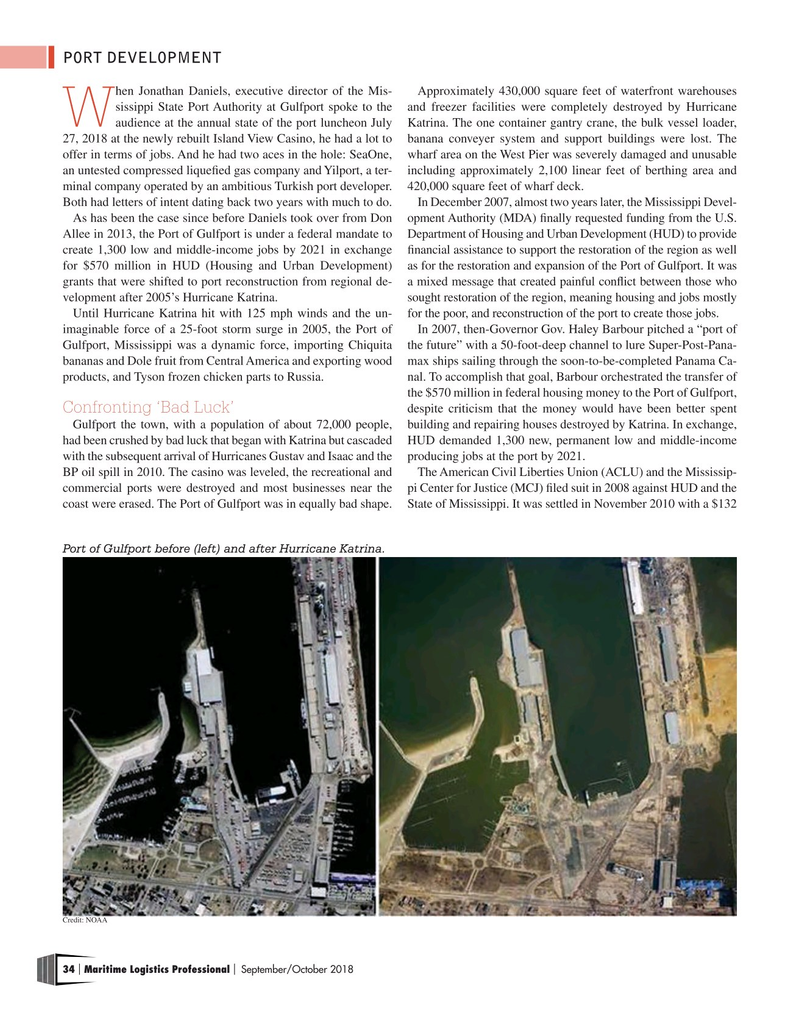
Page 34: of Maritime Logistics Professional Magazine (Sep/Oct 2018)
Liner Shipping & Logistics
Read this page in Pdf, Flash or Html5 edition of Sep/Oct 2018 Maritime Logistics Professional Magazine
PORT DEVELOPMENT hen Jonathan Daniels, executive director of the Mis- Approximately 430,000 square feet of waterfront warehouses sissippi State Port Authority at Gulfport spoke to the and freezer facilities were completely destroyed by Hurricane
Waudience at the annual state of the port luncheon July Katrina. The one container gantry crane, the bulk vessel loader, 27, 2018 at the newly rebuilt Island View Casino, he had a lot to banana conveyer system and support buildings were lost. The offer in terms of jobs. And he had two aces in the hole: SeaOne, wharf area on the West Pier was severely damaged and unusable an untested compressed liquefed gas company and Yilport, a ter- including approximately 2,100 linear feet of berthing area and minal company operated by an ambitious Turkish port developer. 420,000 square feet of wharf deck.
Both had letters of intent dating back two years with much to do. In December 2007, almost two years later, the Mississippi Devel-
As has been the case since before Daniels took over from Don opment Authority (MDA) fnally requested funding from the U.S.
Allee in 2013, the Port of Gulfport is under a federal mandate to Department of Housing and Urban Development (HUD) to provide create 1,300 low and middle-income jobs by 2021 in exchange fnancial assistance to support the restoration of the region as well for $570 million in HUD (Housing and Urban Development) as for the restoration and expansion of the Port of Gulfport. It was grants that were shifted to port reconstruction from regional de- a mixed message that created painful confict between those who velopment after 2005’s Hurricane Katrina. sought restoration of the region, meaning housing and jobs mostly
Until Hurricane Katrina hit with 125 mph winds and the un- for the poor, and reconstruction of the port to create those jobs.
imaginable force of a 25-foot storm surge in 2005, the Port of In 2007, then-Governor Gov. Haley Barbour pitched a “port of
Gulfport, Mississippi was a dynamic force, importing Chiquita the future” with a 50-foot-deep channel to lure Super-Post-Pana- bananas and Dole fruit from Central America and exporting wood max ships sailing through the soon-to-be-completed Panama Ca- products, and Tyson frozen chicken parts to Russia. nal. To accomplish that goal, Barbour orchestrated the transfer of the $570 million in federal housing money to the Port of Gulfport,
Confronting ‘Bad Luck’ despite criticism that the money would have been better spent
Gulfport the town, with a population of about 72,000 people, building and repairing houses destroyed by Katrina. In exchange, had been crushed by bad luck that began with Katrina but cascaded HUD demanded 1,300 new, permanent low and middle-income with the subsequent arrival of Hurricanes Gustav and Isaac and the producing jobs at the port by 2021.
BP oil spill in 2010. The casino was leveled, the recreational and The American Civil Liberties Union (ACLU) and the Mississip- commercial ports were destroyed and most businesses near the pi Center for Justice (MCJ) fled suit in 2008 against HUD and the coast were erased. The Port of Gulfport was in equally bad shape. State of Mississippi. It was settled in November 2010 with a $132
Port of Gulfport before (left) and after Hurricane Katrina.
Credit: NOAA 34 Maritime Logistics Professional September/October 2018 | |

 33
33

 35
35
